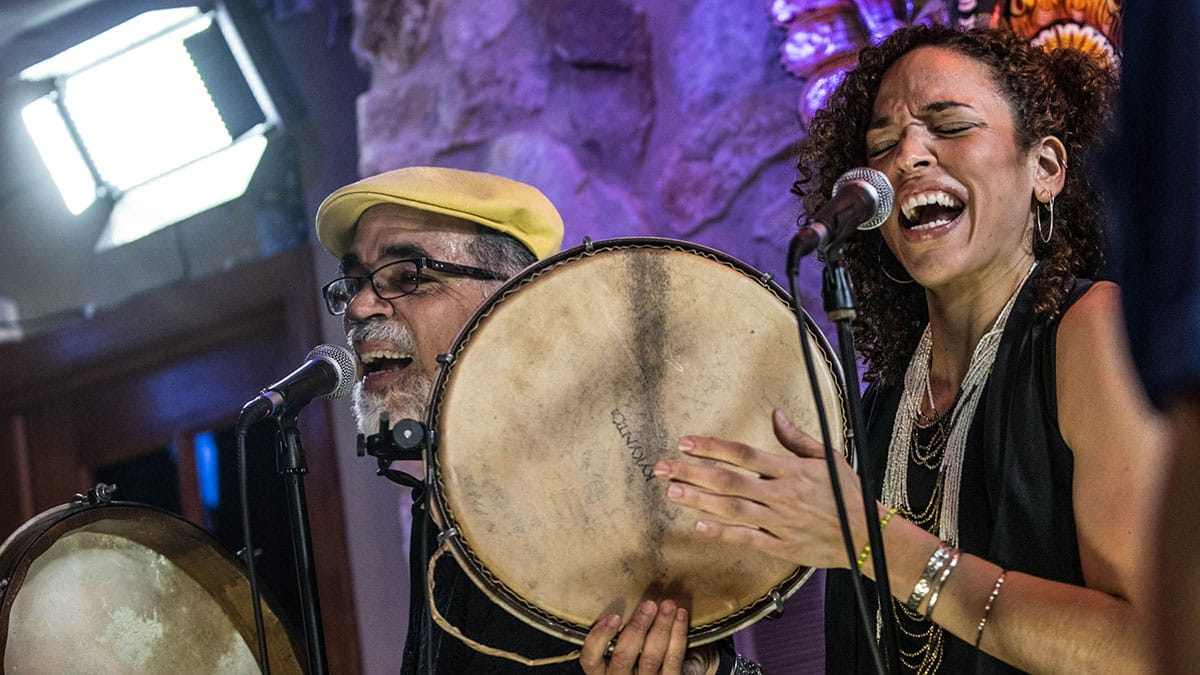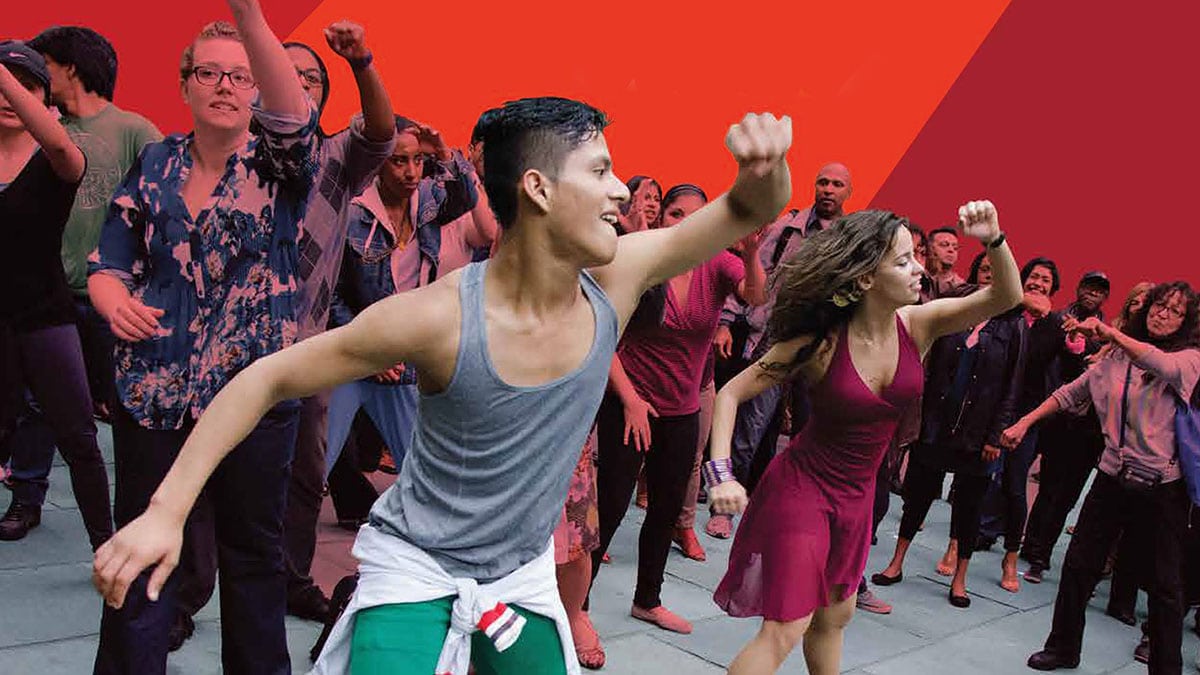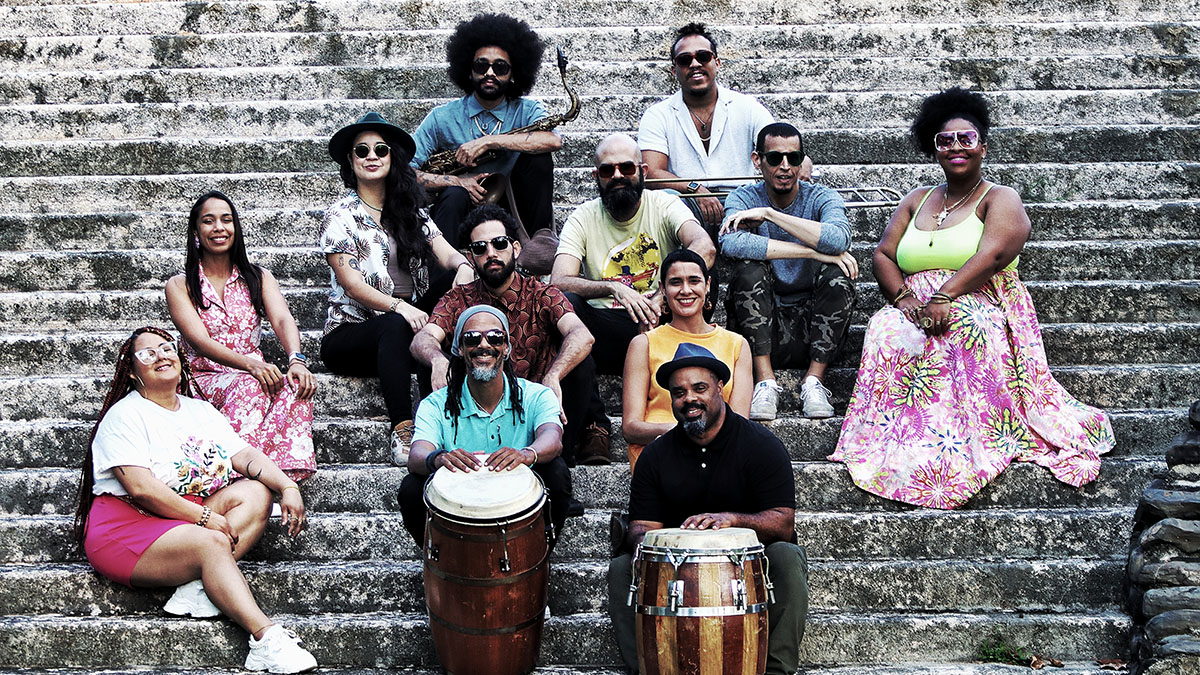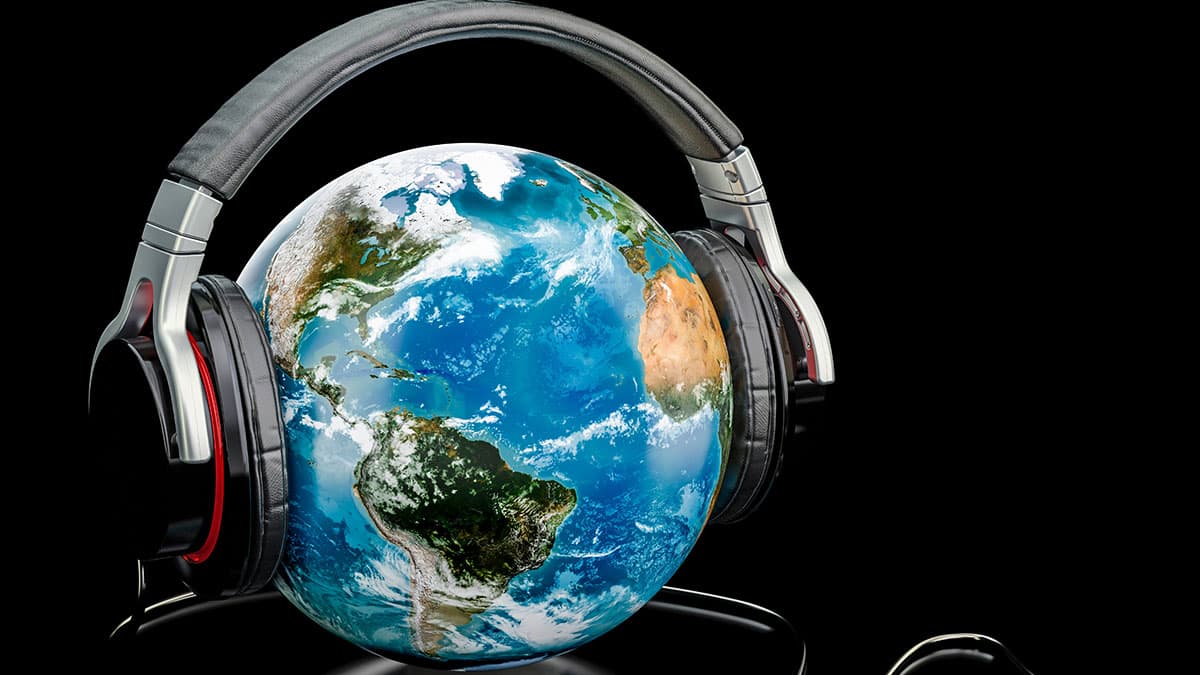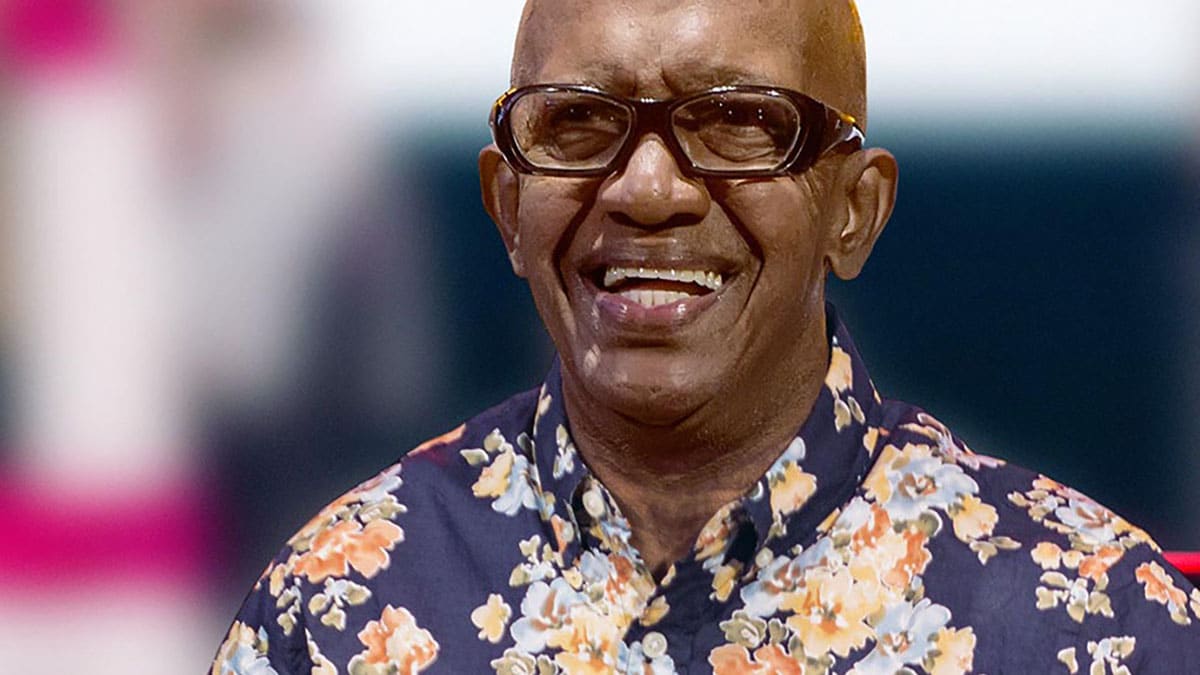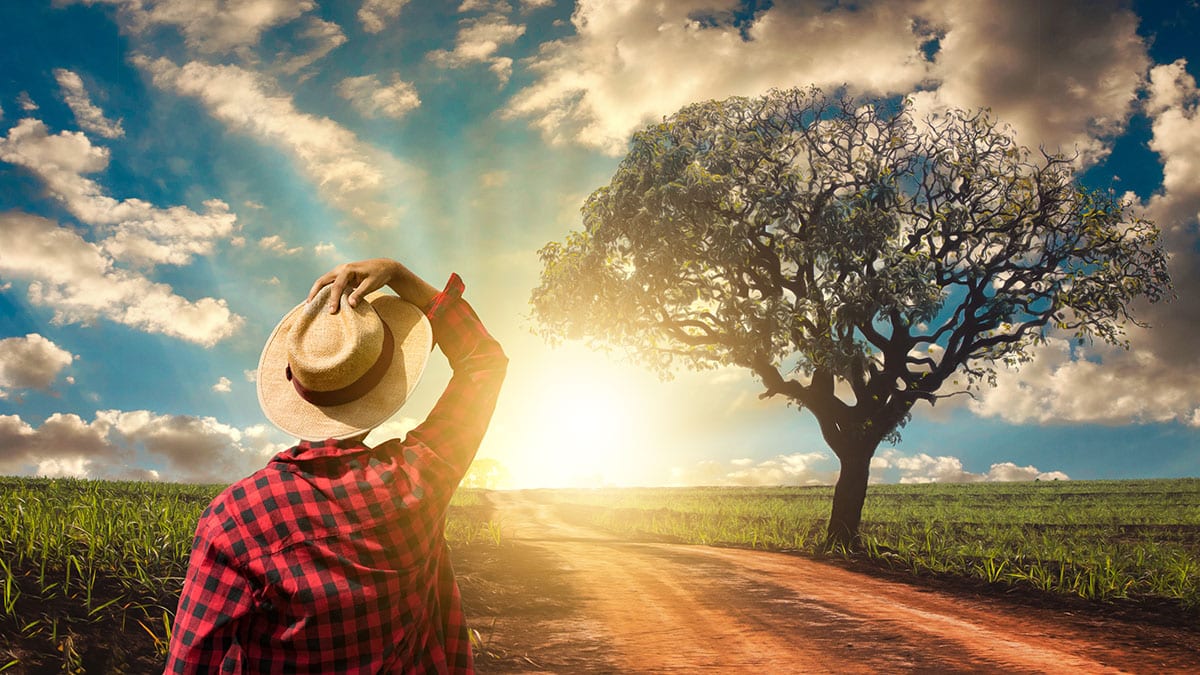Bomba in NYC is a Puerto Rican drum, song, and dance tradition with African roots. The barille drum used to be made from old rum barrels. “Bomba” in Spanish means “pump.” We pump the barille.
The Bomba dancer challenges the lead drummer to match their dance moves. Cuban Rumba Columbia plays a similar game. Women usually dance with a skirt or a scarf. Skirts raised in front of the drummer are the iconic Bomba image. Men have their own styling which is also beautiful to watch.
In Colonial times, traditional drumming was forbidden, but Bomba survived at home in the hills. That’s incredible because you can hear the Bomba barille over a mile away. Today Bomba is an expression of Puerto Rican identity, especially for young people and the Diaspora.
By the way, Bomba and Plena are two completely different things, though they come from the same communities. Salsa has Bomba’s Sicá rhythm in it. Bom, ta-ta, pa… Without Bomba and Plena influences, it’s not Salsa. It was the New York Puerto Rican influence on Cuban Son that created Salsa.
There are important Bomba families in Loíza Aldea, Santurce, Mayagüez, and Ponce. Every region, even every little town has its own unique rhythms.
New York Latin Culture Magazine’s Editor-in-Chief studies Bomba drumming in Puerto Rico with Héctor “Coco” Barez, who was Calle 13’s percussionist.
NYC Bomba Artists
- Bomba Yo @bombayony
- Bombazo Dance Co. @bombazodanceco
- Los Pleneros de la 21
- Priye’ Mawon @priye_mawon 🇵🇷
NYC Bomba Festivals
Puerto Rico Bomba Artists
- Ama Ríos
- Atabal
- Ballet Folklórico Hermanos Ayala @losayalasdeloiza
- El Laberinto de Coco
- Ismael Rivera
- Escuela Bomba Rafael Cepeda @esc.rafaelcepeda
- Mar Cruz y María K Cruz @sebailabomba
- Proyecto Kokobalé @Proyecto_kokobale
- Rafael Cortijo
- William Cepeda @williamcepedaoficial
New York Bomba Features
Midtown Dance 2024 Free Dance Lessons Outdoors in Greeley Square Plaza
GREELEY SQUARE PARK, Koreatown, Manhattan 🇧🇷 🇵🇷
El Laberinto del Coco Plays Afro-Puerto Rican Bomba Fusion for globalFEST at Lincoln Center
DROM, East Village, Manhattan ~ Secret Planet showcase. 🇵🇷
DAVID GEFFEN HALL, Lincoln Center, Manhattan ~ globalFEST world music showcase. 🇵🇷
OLD SAN JUAN, Puerto Rico ~ La Sanse cultural festival. 🇵🇷
WASHINGTON DC, University of Maryland. 🇵🇷
globalFEST is a World Music Showcase at David Geffen Hall in Lincoln Center
DAVID GEFFEN HALL, Lincoln Center, Manhattan ~ alternative, bomba, folk, R&B, rock, world music. 🇺🇸 🇧🇷 🇩🇴 🇫🇷 🇮🇳 🇲🇽 🇲🇦 🇵🇷 🇿🇦 🇪🇸 🇺🇦
Dance Parade NYC 2023 DanceFest Gets over 10,000 New Yorkers Dancing in the Streets
DANCE PARADE
Chelsea, Greenwich Village, East Village
African, Afrobeat, Afro-Cuban, Bhangra, Bollywood, Bomba, Break Dancing, Caporales, Carnival, Dancehall, Flamenco, Folkloric, Hip-Hop, House, Jazz, Latin, Majorette, Mexican, Moko Jumbies, Reggae, Salay, Salsa, Samba, Soca, Street, Tammurriata, Tap, Tarrantella, Tinkus, and more. 🇧🇴 🇧🇷 🇨🇺 🇨🇴 🇩🇴 🇮🇹 🇯🇲 🇲🇽 🇳🇬 🇵🇪 🇵🇷 🇪🇸 🇹🇹
DANCEFEST Tompkins Square Park
🇧🇴 🇨🇺 🇲🇽 🇵🇷 🇪🇸
Saturday, May 20, 2023
Roberto Roena “El Señor Bongó,” was a Bomba and Salsa Legend
LABIOS DULCE, Mayagüez, Puerto Rico, January 16, 1940 🇵🇷
Aloha Boricua is a Puerto Rican Musical About the Migration to Hawaii
PREGONES/PRTT, The Bronx 🇵🇷
New York Bomba News
December 2022
Bomba jazz specialists Papo Vázquez and the Mighty Pirates Troubadours play a Puerto Rican holiday parranda concert, featuring American jazz vocalist Camille Thurman and Puerto Rican cuatro player Héctor Cordero; in the Hostos Center Repertory Theater at Hostos College in Mott Haven, The Bronx; on Saturday, December 10, 2022 at 8pm. TICKETS $15. ($5 students/children) hostos.cuny.org 🇵🇷
October 2022
¡Fuerza Positiva!, the CCCADI Hurricane Fiona Puerto Rico Benefit for artists and cultural workers in Puerto Rico and the Caribbean, features great Rock, Plena, Bomba and Jazz at City Winery in Chelsea, Manhattan on Thursday, October 6, 2022 at 8pm. (6pm doors). From $25. citywinery.com 🇵🇷
March 2022
Enjoy an Afrifemme family afternoon of art therapy, fashion design, and Bomba Puertorriqueña by Bombazo Dance Co, for the Caribbean Cultural Center African Diaspora Institute (CCCADI) and The Shabazz Center in Washington Heights, on Sat, Mar 12 from 1-5pm. Free with registration. 🇵🇷 cccadi.org
September 2021
Sep 9, 2021 ~ In our opinion, the coolest thing happening in Puerto Rico right now is La Bomba-A at Pasito Pasito Waterfront in La Perla, Old San Juan on Mondays at 7:30pm. FREE. Facebook @Pasitoapasitolp
Sep 8, 2021 ~ Here’s some of the coolest Latin fashion we have seen lately. Afrocentrica is a line of clothes and accessories from Loíza Aldea, the town with the strongest African Diaspora culture in Puerto Rico, and one of the island’s centers of bomba culture.
@afrocentricpr 🇵🇷+✊🏾 = ❤️
Bomba Stories
A traditional representation of Bomba.
This is the Batey Ayala in Loíza Aldea during La Fiesta Santiago Apóstol, Loíza’s patron saint festival.
iLe of Calle 13 presents a more modern version of Bomba. The dancers are moving without skirts or scarfs.
Bomba is a living Puerto Rican song, drum and dance tradition. Originally forbidden, it survived in secret at home for 500 years in Puerto Rico’s African Diaspora communities. That’s incredible because you can hear the drums from about a mile away. By the way, “bomba” is not a bomb, it’s a pump. We pump the drums.
Bomba is a uniquely Puerto Rican expression, a blend of our Indigenous, African and European heritage. The communal song, drum and dance tradition comes from Mother Africa. The maracas are both an Indigenous Caribbean and African instrument. We sing in Spanish, a European language, and play drums made from rum barrels, another European element. African drums are made from the whole tree. This is Puerto Rican.
The Cepedas of Santurce, the first family of Bomba, say their tradition comes from a French plantation in Mayagüez. Mayagüez in Western Puerto Rico has always been an entry point for people from the Dominican Republic, Haiti and Cuba. “French” suggests the Diaspora from the Haitian Revolution. We don’t know Bomba’s origins, but these are signs.
Today Bomba is an expression of Puerto Rican identity, both on the island, and in the Diaspora. It’s an expression of family, faith, community and love. Once you get it, your heart will forever after respond instantly to the call of the drum, la llamada de los bariles. ¡Boricua!
Bombazo
Bombazos (bomba gatherings) pop up nightly in town squares across Puerto Rico. The dance’s signature is a flirtatious game where the dancer challenges the lead drummer to match their dance moves with drum beats. The dancer plays or “rings” the drummer with their dance moves.
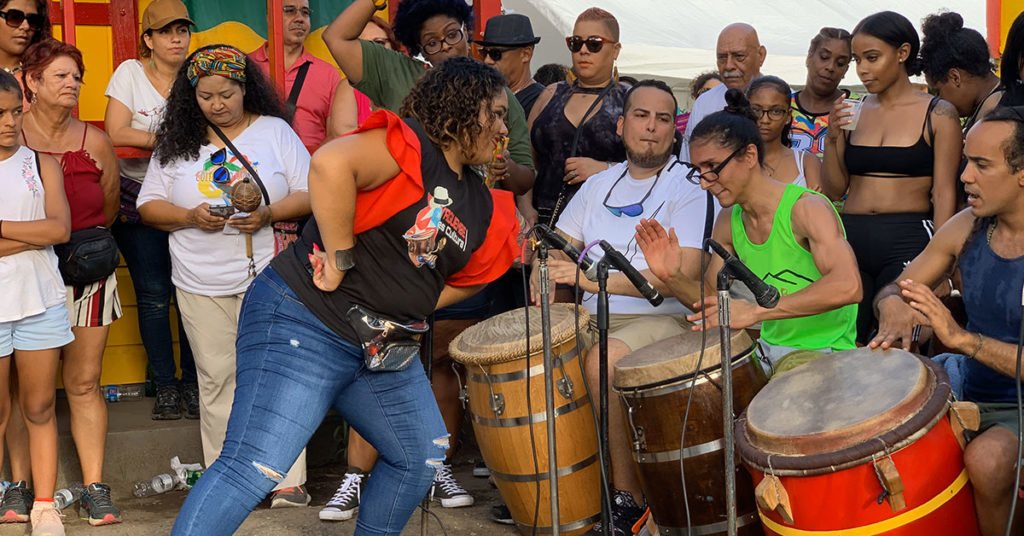
The traditional women’s white peasant dresses and head ties are very regal. The traditional woman’s dance is a skirt dance, but today people dance in whatever they are wearing. Sometimes women will pass around a skirt, but it’s not necessary. Only connection is necessary. Men dance too. They basically strut.
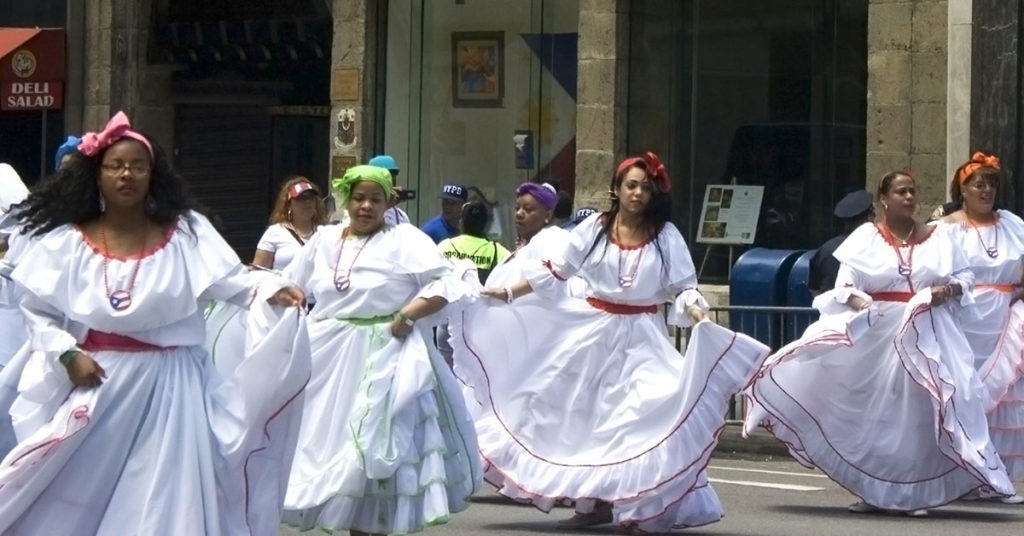
Bomba is Puerto Rican Identity
All human culture begins as rituals of family and faith. Bomba traditions originate in West African rituals where the same sacred rhythms and movements have been used to connect with our ancestors since the beginning of human time. Some still practice their faith in private, but contemporary bomba is only about family and community.
Dancing bomba is about being Puerto Rican.
The Drum Heals
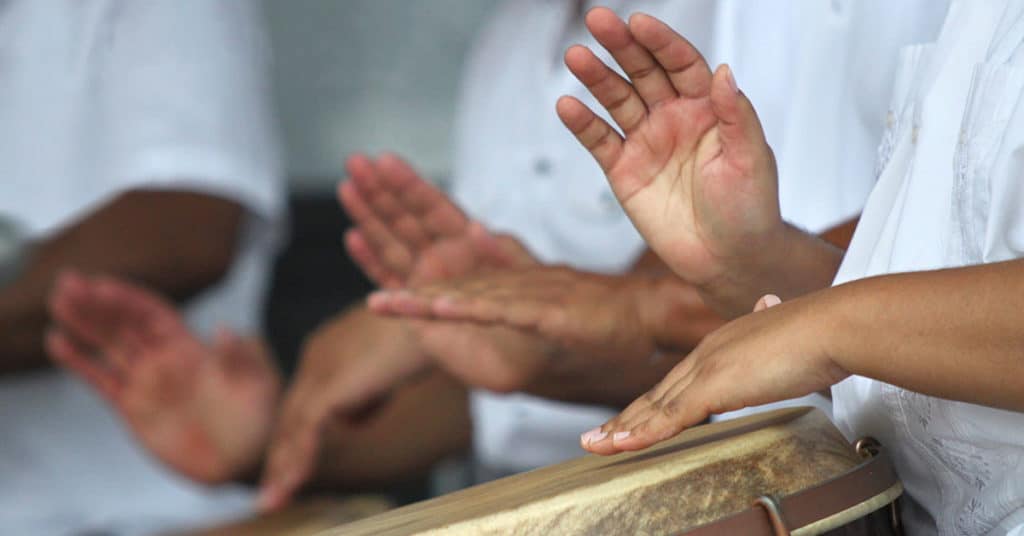
There are drum traditions everywhere in the world and the culture that surrounds them is surprisingly similar everywhere in the world. Bomba drums or “barrilles” are made from wooden barrels which often carried rum, but were the standard shipping containers of colonial times.
The larger bomba drum is a buleador. It uses a male goat skin to keep the basic rhythm. The smaller drum is a subidor. It is the lead drum used to follow the dancer’s movements. The subidor uses female goat skin because it creates a higher pitch.
Dancing is an expression of both belonging to a group and one’s individuality within the group, but the African drum is also a healing instrument. We may drum, sing and dance to pay our respects to family and ancestors, to find love, just for fun, or to wash away the pains of life.
Drumming, singing and dancing are a powerful traditional form of folk therapy. Colonizers never understood this. They were constantly surprised that after being brutalized all day, we were out singing and dancing that night. They never understood that we had to sing and dance to wash away the pain in order to survive another day living under the colonial system.
Creole Roots
It doesn’t seem to be mentioned in the literature, but one of the seeds of bomba must be the French Creole diaspora created by the turmoil of the Haitian Revolution (1791-1804). There are French Creole footprints all over the Caribbean and many signs in Puerto Rico.
The Cepeda family, one of the leading families of bomba, says their tradition comes from their family history working on a French plantation in Mayagüez. In the Caribbean, “French” often means the Haitian diaspora.
Indigenous Elements
At the time of European contact, Puerto Rico was populated by Indigenous Taíno. The colonizer myth is that Indigenous people were “wiped out.” That’s a lie told to justify stealing Indigenous land and valuables. The reality is we intermarried. Indigenous cultural traditions and place names remain very much a part of Puerto Rican life.
Cuás are wooden sticks used to mark time. Latin musicians call them claves because they are used to mark the essential clave rhythm of the Americas. In bomba, cuás are often used with a small barrel drum.
Maracas were originally a Taíno instrument made from the fruit of the higuera tree.
Related Traditions
There are similar, but distinct African diaspora drum traditions across the Caribbean and South America including: Cuban rumba, Colombian cumbia, Venezuelan tambor, Brazilian samba, Uruguayan candombe and many others. Argentine tango originates in similar traditions, but the African root is hidden underneath European traditions. You can still hear the habanera though: pum, ta-da, pum pum, ta-da, pum pum.
The shared roots are obvious, but each tradition is actually a unique blend of people, geography and history.
Bomba and Plena
Bomba and plena are distinct Puerto Rican drum traditions, but they are often performed by the same groups. Plena is the Puerto Rican singing news tradition sung with small hand drums. It is rooted in the West African griot tradition of traveling storytellers and the similar European troubadour tradition.
Bomba is rooted in the past, but it also influences the present. Salsa is a New York musical form, but you don’t get salsa without bomba and plena. Salsa blends Cuban rumba and son, Puerto Rican bomba and plena, and New York jazz (which itself is rooted in Caribbean New Orleans and the Haitian diaspora there).
Drumming, singing and dancing defines us as American Latins, a mix of Indigenous, European and African traditions. Even hip-hop and reggaeton are further steps in the same line. Watch a bomba party, a hip-hop party and a reggaeton party. The music is a little different, but the communal traditions are very similar.
The way a break dancer or reggaeton dancer enters the communal dance floor, salutes the crowd and then struts their stuff is just like bomba. The dance line in the 1970s dance show Soul Train was basically the same thing.
Bomba Lives in the Hearts of All Puerto Ricans
In the 1950s, Rafael Cortijo put bomba into popular salsa music. This influenced his childhood friend, the famed singer Ismael Rivera (El Nazareno, La Cara Linda), legendary bandleader Tommy Olivencia (Trucutu, Plante Bandera) and others.
By the 1970s, bomba was almost dead. It survived in the family traditions of the Cepeda Family in Villa Palmera, Santurce, San Juan, the Ayala Family of Loíza, Loíza (who also created the Loíza style of coconut vejigante mask) and the Alduén Family of Mayagüez.
The Cepeda family are a family of teachers. Modesto Cepeda, the son of patriarch Don Rafael Cepeda, began wondering who would lead bombazos after his father passed, so he started teaching it.
The family took an abandoned building in Villa Palmeras and turned it into a beautiful bomba and plena cultural center, Escuela de Bomba y Plena Rafael Cepeda Atiles (Facebook).
In 2017, right before Hurricane Maria hit, Modesto Cepeda was recognized with an NEA National Endowment for the Arts, National Heritage Fellowship Award. The entire family are national treasures.
Today young Puerto Ricans are projecting bomba out into the world in a variety of interesting fusions. The El Laberinto del Coco project of bomba drummer Hector Barez (Calle 13, SXSW) is a great example.
Bomba lives. African spirit will live forever because it is the ancestral spirit of all humanity.
More Bomba Stories
You can really see in these videos how these are family traditions. Dancing bomba makes you part of the Puerto Rican family.
Yet none of these photos or videos really captures the feeling of being with the drum. If you can, go to a bombazo, and don’t sit in the back. Get as close to the drums as you can. Then you will know what is ¡Bomba!
Ta-ta-ta, pa-da-la-da, ta, ta-ta, ta-ta
Bom, ta-ta, pa…Bom, ta-ta, pa…Bom, ta-ta, pa…

